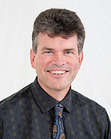E.C. Blake's Blog, page 5
March 30, 2018
Cover art reveal: my next DAW novel, Worldshaper
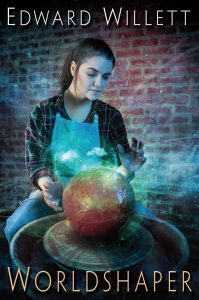 Amazon U.S. | Amazon Canada | Indigo | Barnes & Noble | Penguin Random House
Amazon U.S. | Amazon Canada | Indigo | Barnes & Noble | Penguin Random House
Worldshaper (written as Edward Willett) will be my ninth novel for DAW Books, coming out September 18 in hardcover and ebook. It’s the start of a new series called Worldshapers. The artwork is by Juliana Kolesova, who happens to also be from Canada–she works out of Toronto.
Here’s the description:
From an Aurora Award-winning author comes the first book in a new portal fantasy series in which one woman’s powers open the way to a labyrinth of new dimensions.
For Shawna Keys, the world is almost perfect. She’s just opened a pottery studio in a beautiful city. She’s in love with a wonderful man. She has good friends.
But one shattering moment of violence changes everything. Mysterious attackers kill her best friend. They’re about to kill Shawna. She can’t believe it’s happening–and just like that, it isn’t. It hasn’t. No one else remembers the attack, or her friend. To everyone else, Shawna’s friend never existed…
Everyone, that is, except the mysterious stranger who shows up in Shawna’s shop. He claims her world has been perfect because she Shaped it to be perfect; that it is only one of uncounted Shaped worlds in a great Labyrinth; and that all those worlds are under threat from the Adversary who has now invaded hers. She cannot save her world, he says, but she might be able to save others–if she will follow him from world to world, learning their secrets and carrying them to Ygrair, the mysterious Lady at the Labyrinth’s heart.
Frightened and hounded, Shawna sets off on a desperate journey, uncertain whom she can trust, how to use her newfound power, and what awaits her in the myriad worlds beyond her own.
October 3, 2017
My latest column: Pulp Fiction
This is my latest column from the Saskatchewan Writers Guild magazine Freelance , with extra graphics!
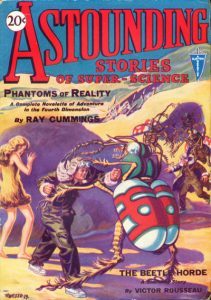 Mention “pulp fiction” these days and most people probably think of the 1994 Quentin Tarintino movie. But of course the movie’s title referenced something much earlier: fiction literally published on pulp—cheap paper made directly from wood-pulp.
Mention “pulp fiction” these days and most people probably think of the 1994 Quentin Tarintino movie. But of course the movie’s title referenced something much earlier: fiction literally published on pulp—cheap paper made directly from wood-pulp.
Pulp paper quickly turns both yellow and brittle, and perhaps that perception of poor quality has coloured the perception of the fiction printed thereon, but of in fact many classic stories—not just of science fiction and fantasy, but in other genres, too—first appeared in what are now known as the “pulp magazines.”
Mike Ashley is a U.K. researcher and editor who has published four books on the history of science fiction magazines just since 2000, with a fifth in the works. In a recent essay on The Pulp Magazines Project website, he offers a quick history of pulp magazines.
He defines pulps narrowly, as magazines not only printed on pulp paper, but of a standard size, about 10 X 7 inches. Their glory years were 1896 to 1955. After that, they largely vanished. Some magazines became larger and moved to better paper, while the few survivors mostly shrank to digest size, roughly 7 X 5 inches.
The magazines lacked bulk advertising: they were so cheap to produce that even though they typically sold for a dime, they could survive solely off of sales revenue. Illustrations were limited to line drawings, because photos wouldn’t reproduce well.
The direct ancestors of the pulps were dime novels and boys’ adventure magazine. (Interestingly enough—to me, at least—a previous Edward Willett wrote dime-novel Westerns.)
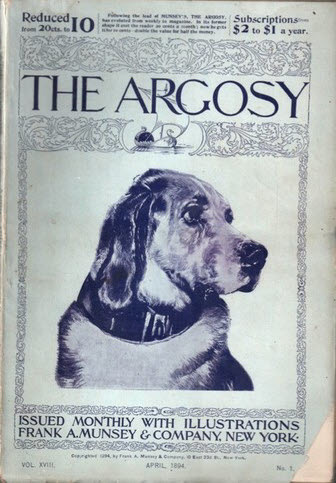 Ashley pegs the first proper pulp as The Argosy, born as The Golden Argosy, a weekly boys’ adventure magazine, in December 1882). The name change in December 1888 was an attempt to attract a more grown-up readership. It moved to the pulp format in April 1894 (the image is the cover of that first pulp issue.) The focus remained on adventure stories, but more serious work was also serialized, such as Upton Sinclair’s novel In the Net of the Visconti.
Ashley pegs the first proper pulp as The Argosy, born as The Golden Argosy, a weekly boys’ adventure magazine, in December 1882). The name change in December 1888 was an attempt to attract a more grown-up readership. It moved to the pulp format in April 1894 (the image is the cover of that first pulp issue.) The focus remained on adventure stories, but more serious work was also serialized, such as Upton Sinclair’s novel In the Net of the Visconti.
The overall model, though, was exciting adventure fiction, sold cheaply, and it worked so well that by 1907 The Argosy was selling half a million copies of every issue, making it second in circulation among American magazines.
Success bred imitators—lots of them, far too many to list here. The early pulps had an eclectic approach to fiction, but specialty magazines soon appeared, beginning with 1906’s The Railroad Man’s Magazine, in which all the stories were linked to railways.
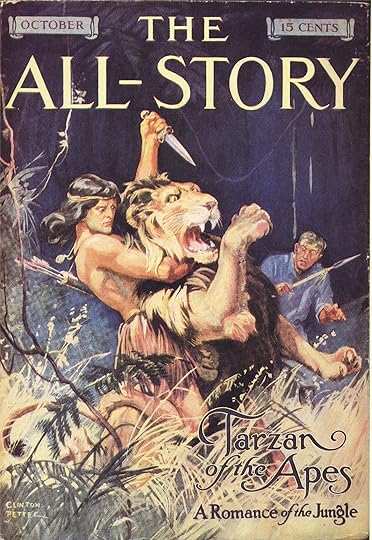 In October 1912 All-Storypublished Tarzan of the Apes by Edgar Rice Burroughs. His Martian adventures featuring John Carter followed. Their success led to even more fantastical stories (though there’d always been some) appearing in the pulps.
In October 1912 All-Storypublished Tarzan of the Apes by Edgar Rice Burroughs. His Martian adventures featuring John Carter followed. Their success led to even more fantastical stories (though there’d always been some) appearing in the pulps.
Science-fiction readers finally got their own magazine with Amazing Stories, started by Hugo Gernsback in April 1926. Though it was the first science-fiction magazine, Ashley points out it wasn’t really a pulp: initially, it used a larger format and heavier paper. As a result, the honour of being the first true science-fiction pulp goes to 1930’s Astounding Stories (whose first cover graces—if that’s the right word—the top of this column).
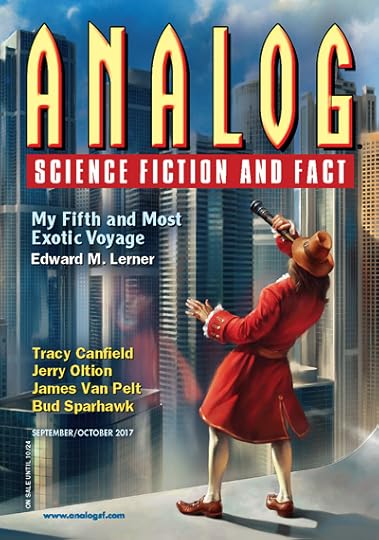 Amazing Stories continued in print form until 2005, but the real “amazing story” is Astounding’s. Renamed Analog in 1960, it continues to this day: you can find it in Chapters as a digest-sized magazine published on cheap paper (though better paper than the original pulps used!). That’s the cover of the most recent issue at right.
Amazing Stories continued in print form until 2005, but the real “amazing story” is Astounding’s. Renamed Analog in 1960, it continues to this day: you can find it in Chapters as a digest-sized magazine published on cheap paper (though better paper than the original pulps used!). That’s the cover of the most recent issue at right.
Other science-fiction pulps included Wonder Stories, Startling Stories, and Planet Stories, which introduced such writers as Robert A. Heinlein, Isaac Asimov, Arthur C. Clarke, Ray Bradbury, Philip K. Dick, and L. Ron Hubbard. On the fantasy side, Weird Talespublished H.P. Lovecraft, and Robert E. Howard’s tales of Conan the Barbarian.
The number of pulps dwindled during the Second World War, and by the mid-1950s they’d almost all vanished, “victim,” Ashley says, “to all manner of afflictions—comics, paperbacks, television, and eventually the withdrawal of their major distributor.”
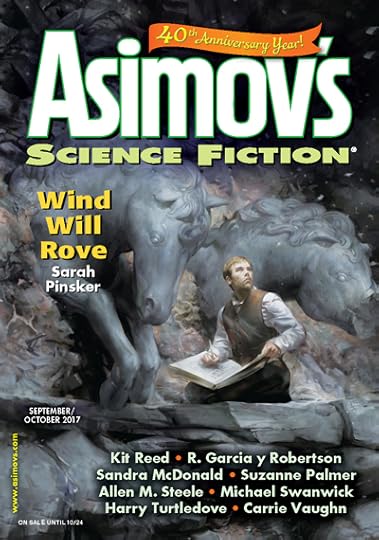 And yet their spiritual descendants live in science fiction and fantasy in the form of the “Big Three”: the aforementioned Analog, Asimov’s Science Fiction Magazine (launched in 1977), and The Magazine of Science Fiction and Fantasy(1949).
And yet their spiritual descendants live in science fiction and fantasy in the form of the “Big Three”: the aforementioned Analog, Asimov’s Science Fiction Magazine (launched in 1977), and The Magazine of Science Fiction and Fantasy(1949).
In the larger literary world, there’s a movement called New Pulp (“stories by modern fans and authors that recreate the style of adventures that appeared in the pulp magazines during the pulp era,”), which has an annual convention called PulpFest.
And in science fiction specifically, there’s the Pulp Revolution. Jasyn Jones, one of its adherents, defines it thus:
“The Pulp Revolution…is about learning from the past how to make great stories. It’s about grabbing the audience right out of the gate and keeping them mesmerized by moving the story along. It’s about the absolute minimum of boring talky baloney, and the absolute maximal entertainment, enjoyment, and fun. It’s about audience first, last, and always. It’s about eschewing all else in pursuit of stories that inspire, that thrill, that horrify, that move, that elate. It’s about storytelling in its purest and most elemental form. It’s about all that…”
From my point of view, “all that” sounds pretty sweet.
Pulp fiction lives!
My latest novel is science fiction: The Cityborn
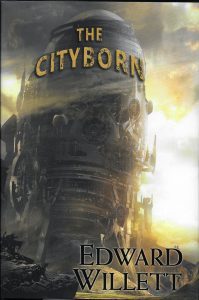 My latest novel (my eighth from DAW Books) is The Cityborn, a stand-alone science fiction tale.
My latest novel (my eighth from DAW Books) is The Cityborn, a stand-alone science fiction tale.
What’s it about? Glad you asked! Herewith, the blurb, followed by some very nice reviews, and a link to sample chapters and buying opportunities.
Two young individuals must uncover the dark secrets of their stratified city in this suspenseful sci-fi standalone.
The metal City towers at the center of the mountain-ringed Heartland, standing astride the deep chasm of the Canyon like a malevolent giant, ruled with an iron fist by the First Officer and his Provosts in the name of the semi-mythical Captain. Within its corroding walls lies a stratified society, where the Officers dwell in luxury on the Twelfth Tier while the poor struggle to survive on the First and Second, and outcasts scrabble and fight for whatever they can find in the Middens, the City’s rubbish heap, filling the Canyon beneath its dripping underbelly.
Alania, ward of an Officer, lives on Twelfth. Raised among the privileged class, Alania feels as though she is some sort of pampered prisoner, never permitted to explore the many levels of the City. And certainly not allowed to leave the confines of the City for any reason. She has everything a young woman could want except a loving family and personal freedom.
Danyl, raised by a scavenger, knows no home but the Middens. His day-to-day responsibility is to stay alive. His sole ambition is to escape from this subsistence existence and gain entrance to the City—so near and yet so far out of reach—in hopes of a better life.
Their two very different worlds collide when Alania, fleeing from an unexpected ambush, plunges from the heights of the City down to the Middens, and into Danyl’s life.
Almost immediately, both of them find themselves pursued by the First Officer’s Provosts, for reasons they cannot fathom—but which they must uncover if they are to survive. The secrets they unlock, as they flee the Canyon and crisscross the Heartland from the City’s farmlands to the mountains of the north and back again, will determine not only their fate, but the fate of the City…and everyone who lives there.
One of Inverse Entertainment’s “7 Essential Science Fiction Books for July 2017” and Barnes & Noble’s “The Best Science Fiction & Fantasy Books of July 2017.”
Read my “Big Idea” essay for John Scalzi’s popular blog Whatever
“Willett brings J.G. Ballard’s High-Rise into the distant space age in this dystopian tale of class, power and freedom that will entertain devotees and non-genre fans alike. The worldbuilding in this book is impressive, creating an atmosphere that is both fascinating and oppressive, and characters who are magnificently complex…the ending provides a fascinating study about loyalty and power that grounds this book in our own time as much as the titular city of Willett’s imagination.”
“Willett (the Helix War series) wraps his capable new adult science fiction adventure around the fate of a mysterious many-tiered city and its inhabitants…Willett’s spunky protagonists and colorful world will entertain SF adventure fans.”
“ A novel that doesn’t promise an entire trilogy? Be still our hearts. Edward Willett’s The Cityborn does fill that niche, but it’s a decent read, too…if you’re thirsting for a sci-fi read and don’t want to get tangled up in having to remember plenty of details for more than a single book, The Cityborn should appeal to you.”
“I’ve finally read a dystopian that I’ve enjoyed…I’d definitely recommend The Cityborn , especially for fans of sci-fi looking to branch into dystopian, and for readers like me who are tired of the typical dystopians out there.”
“Dystopian stories are my all time favorite and I couldn’t wait to get into The Cityborn …once things start going, you will be flipping the pages as fast as Alania and Danyl are moving to keep ahead of the Provost. There is a lot happening in this story and it does a great job of building the world we find ourselves in…Overall this is a great dystopian story. It’s my first book from Edward Willett and I hope to read more of his books.”
“This was some crazy shjt. Not that anything is new under the post-apoc/SciFi sun, but the way it was constructed and interleaved with the characters makes it inescapably poignant.”
Interviews: NovelKnight, Unbound Worlds
You can get it here:
Amazon U.S. | Amazon Canada | Indigo | Barnes & Noble | Penguin Random House
September 4, 2016
My editor wins a Hugo, and other notes from my summer vacation
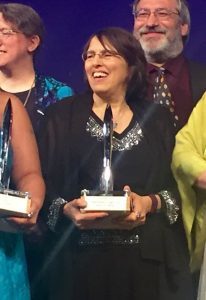 It’s been a while since my last post. Lots to tell you about, but let’s start with the most important: my wonderful editor (and publisher), Sheila E. Gilbert of DAW Books, received the Hugo Award for Best Editor (Long-Form) at this year’s World Science Fiction Convention in Kansas City–and as you can see, I was there to take a photo.
It’s been a while since my last post. Lots to tell you about, but let’s start with the most important: my wonderful editor (and publisher), Sheila E. Gilbert of DAW Books, received the Hugo Award for Best Editor (Long-Form) at this year’s World Science Fiction Convention in Kansas City–and as you can see, I was there to take a photo. 
August 4, 2016
My WorldCon schedule

I’m looking forward to being in Kansas City in a couple of weeks for the World Science Fiction Convention. I’ve got my complete schedule now: if you’re attending, hope to see you there! (I’ll be in my Edward Willett guise, not my E.C. Blake one.)
New Trends in Young Adult Novels
Thursday 12:00 – 13:00, 2503A (Kansas City Convention Center)
What’s new in young adult fiction? It seems like YA changes faster than anything else in the market, but is that really true? What themes are hot today? What topics are now taboo? And what can we look forward to in the near future?
Ms Rachel Neumeier, Christine Taylor-Butler (M), Jane Ann McLachlan, Edward Willett, Denise Grover Swank
Middle Grade and Young Adult Fiction: What’s the Difference?
Thursday 17:00 – 18:00, 2208 (Kansas City Convention Center)
YA and MG, it’s all just kids lit, right? Not necessarily. James and the Giant Peach is a much different story than The Hunger Games, and yet the two audiences often get lumped together — like we’re doing here. So, let’s break them apart. Panelists discuss defining characteristics of Young Adult and Middle Grade fiction, differences in world view, special problems — and provide some literary examples.
Kathryn Sullivan (M), Christine Taylor-Butler, Rebecca Moesta, Edward Willett, Adam-Troy Castro
Latchkey Kids in Fiction
Friday 10:00 – 11:00, 2206 (Kansas City Convention Center)
Parents are often missing (or at least sidelined) in today’s young adult fiction. With the emergence of these latchkey kids who come home to empty houses and who have very little (if any) parental supervision, what message is this sending to today’s readers? What purpose do these absentee parents play in the larger story? Sure, it ratchets up the tension, but why is it such a common theme? Moreover, what resources are available to these latchkey kids and what dangers should they keep in mind when operating without a parent?
Tina Connolly (M), James Van Pelt, Tamora Pierce, Sarah Beth Durst, Edward Willett
Kaffeeklatsch: Jennifer Brozek, Ken Liu, Bud Sparhawk, Edward Willett
Friday 15:00 – 16:00, 2211 (KKs) (Kansas City Convention Center)
Autographing: Ctein, Tanglwyst de Holloway, Esther Friesner, James Patrick Kelly, Kathryn Sullivan, Edward Willett
Saturday 11:00 – 12:00, Autographing Space (Kansas City Convention Center)
YA Fiction Beyond Borders
Saturday 17:00 – 18:00, 3501F (Kansas City Convention Center)
Young adult fiction is a strong and thriving market in the U.S., but how is it doing internationally? We discuss the books and authors beyond mainstream “America’s literary borders” that deserve recognition. Is there a difference in approach, content, characters, and diversity of topics and themes? How do we continue to break down these borders and barriers for YA readers and authors alike?
Mr. Peadar O Guilin, Keith Yatsuhashi, Shanna Swendson, Edward Willett, Christopher Kastensmidt (M)
Reading: Edward Willett
Sunday 13:30 – 14:00, 2202 (Readings) (Kansas City Convention Center)
August 1, 2016
My latest young adult fantasy: Flames of Nevyana
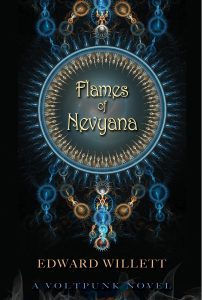 if you enjoyed the Masks of Aygrima trilogy, you’d probably also enjoy my latest YA fantasy novel (written as Edward Willett), Flames of Nevyana, from Rebelight in Winnipeg.
if you enjoyed the Masks of Aygrima trilogy, you’d probably also enjoy my latest YA fantasy novel (written as Edward Willett), Flames of Nevyana, from Rebelight in Winnipeg.
Here’s the synopsis:
Blue Fire is both blessing and curse. A gift from the gods, its mystical light and energy powers and protects the land of Nevyana, but it also divides her people into three distinct groups. In the wrong hands, it becomes a formidable weapon. When sacred objects for channelling Blue Fire are stolen, sworn enemies Petra, Amlinn, and Jin set out to find them, and their paths converge on a collision course with the truth. Can they bridge the centuries-old divide between their communities? Or will their search for the truth and the explosive power of Blue Fire signal the end of Nevyana?
It’s available from Amazon.com and Chapters/Indigo. Be the first on your block to read it!
If you’d like a taste, you can read the first two chapters online now!
My new young adult fantasy Flames of Nevyana releases!
 It’s release day for my new YA fantasy novel (written as Edward Willett), Flames of Nevyana, from Rebelight in Winnipeg. The paperback version is available for order now, with the ebook still to follow.
It’s release day for my new YA fantasy novel (written as Edward Willett), Flames of Nevyana, from Rebelight in Winnipeg. The paperback version is available for order now, with the ebook still to follow.
Here’s the synopsis:
Blue Fire is both blessing and curse. A gift from the gods, its mystical light and energy powers and protects the land of Nevyana, but it also divides her people into three distinct groups. In the wrong hands, it becomes a formidable weapon. When sacred objects for channelling Blue Fire are stolen, sworn enemies Petra, Amlinn, and Jin set out to find them, and their paths converge on a collision course with the truth. Can they bridge the centuries-old divide between their communities? Or will their search for the truth and the explosive power of Blue Fire signal the end of Nevyana?
It’s available for order now from Amazon.com and Chapters/Indigo. Be the first on your block to read it!
If you’d like a taste, you can read the first two chapters online now!
How to Write Young Adult Fantasy: More Story, Less Pretentiousness
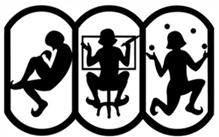 A little while ago I gave a talk at the offices of the Saskatchewan Writers Guild for the Saskatchewan chapter of CANSCAIP, the Canadian Society of Children’s Authors, Illustrators and Performers (that’s their logo at left). This is more or less what I said.
A little while ago I gave a talk at the offices of the Saskatchewan Writers Guild for the Saskatchewan chapter of CANSCAIP, the Canadian Society of Children’s Authors, Illustrators and Performers (that’s their logo at left). This is more or less what I said.
I didn’t start out as a writer. Like most writers, I started out as a reader.
My parents loved to read, and I had two older brothers who also read a lot, so our house was always full of books. I remember practicing my reading with my mother by reading out loud to her. Since it was the King James Version of the Bible, I didn’t always have a clue what I was reading, but at least I was figuring out how to sound out words.
What really captured my interest, though, was science fiction and fantasy. Again, I blame my brothers. That was what they read, and of course I wanted to be like them, so that was what I read. One of the earliest novels I can remember reading was Revolt on Alpha C, by Robert Silverberg. It had starships and ray guns and all kinds of other science fictional goodness. I was a nine-year-old boy. How could I not be hooked? (It wasn’t until years later I discovered that was Silverberg’s first novel, written when he was only 19.)
But I didn’t just read science fiction and fantasy. I read everything, voraciously. History books and adventure books, horse books and dog books, classics and not-so-classics. In school I was the kid who was always raising his hand in class and then saying, “I read somewhere …”
Because I read, I occasionally knew more about a subject than my teachers. (Sorry, teachers, but that is a hazard of teaching kids to read.) For example, I loved a series of English children books called Swallows and Amazons, by Arthur Ransome, which are all about kids sailing. I knew from those books that the “sheet” on a sailing boat is actually a rope that controls the angle of the sail. I had a teacher who told the class that the “sheet” was the sail. Naturally, I couldn’t let that stand, and the discussion grew…a little heated. But I’m sure that once, upon reflection, she realized she was wrong and I was right, she appreciated my ten-year-old self for setting her straight. Although I admit she didn’t say so at the time.
Books transported me to places I could never have gone: real places, imaginary places, might-have-been places and might-yet-be places. They taught me about airplanes, aardvarks, auto racing, astronauts and apples–and that was just the A’s.
I was always drawn to science fiction and fantasy, because my older brothers read that stuff and so it was in the house. The books of Robert A. Heinlein and Andre Norton were too of my biggest influences; later, of course, I read Tolkien and Lewis, but I hadn’t even gotten to them yet when I decided I wanted to write my own stories.
One reason was that I sometimes couldn’t find the kinds of stories I really enjoyed reading. (Today’s fortunate children live in the Golden Age of YA fantasy and science fiction; in my day such books were few and far between.) I thought, well, maybe I should just create my own. But I didn’t want to write just for myself. I wanted to write for readers: I wanted to tell stories that readers would enjoy as much as I enjoyed the books I loved.
And so, when I was 11 years old, I wrote my first short story, “Kastra Glazz: Hypership Test Pilot.” And my Grade 7 English teacher in Weyburn, Tony Tunbridge, did me the great courtesy of taking it seriously: he critiqued it, and didn’t just tell me that it was wonderful (which, in retrospect, it really wasn’t), he told me how I could make it better. That lit a fire in me: my next story would be better.
I’ve been writing stories ever since. I wrote three novels in high school (and passed them around for my classmates to read: rather brave of me, I think now, but extremely valuable—I learned that I could, in fact, write stories that people enjoyed, even if the girls made fun of my love scenes), and kept on writing novels, year after year, until, finally, I started getting them published.
And although that first short story and first longer piece (The Pirate Dilemma! Starring Roy B. Savexxy and Samuel Domms! Double consonants proves it’s science fiction!) were SF, my first novel, written in my Grade 10 English “writing book” (we were required to write one page a day of something—anything) at age 14, was a fantasy entitled The Golden Sword (rewritten as The Silver Sword in Grade 12 when I realized you could barely lift a sword made out of solid gold, much less fight with it.) I wrote an adventure story next, Ship from the Unknown (about an entire nation powerful enough to take on the U.S. and the USSR combined, which somehow had escaped detection deep in the Amazon rainforest…hey, I was 15) then went back to fantasy with Slavers of Thok, my high school magnum opus, which you could tell was epic because it had a map and everything.
Viva la difference
A quick side note to answer the common question, “What’s the difference between science fiction and fantasy?”
According to Orson Scott Card, “science fiction has rivets, fantasy has trees.” According to the most persnickety hard science fiction writers, fantasy is “writing with the net down,” because you don’t have to make your fictional world obey natural law as we understand it. I usually say the difference is that the fantastical things that happen in the SF novel are at least given a scientific explanation, even if it ultimately ends up being so much hand-waving, while you don’t need much more explanation than “magic” for a fantasy novel. Although it’s always worth remembering Clarke’s Law: “Any sufficiently advanced technology is indistinguishable from magic,” and there are certainly science fiction novels that read exactly like high fantasy novels: Gene Wolfe’s series The Book of the Long Sun or Robert Silverberg’s Lord Valentine’s Castle to name just a couple.
I always thought of myself more as a science fiction writer than a fantasy writer, but my first two published novels, Soulworm and The Dark Unicorn, were fantasy—one modern-day fantasy, one high fantasy. Both were young adult, and there’s no doubt that on the YA side I’ve definitely written more fantasy than science fiction: Spirit Singer, The Shards of Excalibur series, The Haunted Horn, The Masks of Aygrima trilogy (though not published as YA, it has a 15-year-old protagonist and is essentially YA), and the upcoming Flames of Nevyana.
Writing for me is all about telling stories. I find a lot of writers are way too pretentious about what it is they do. Very few books change society and become lasting literature that is taught for generations, and while that’s a fine thing to aspire to, I suppose, the truth is there’s no way for anyone to know what will last and what won’t. This year’s “important new novel” is next year’s stack of ignored books on the bargain shelves at Chapters. All that stuff in reviews about “shines a light on” and “shatters our illusions” and “carries an important message” I find silly, like a lot of the descriptors used in wine writing or the overwrought artspeak used in those descriptive panels hung next to works in galleries. As far as I’m concerned, a book succeeds or fails based on a single criteria: does it tell a good story?
The other stuff—the “shining a light on” and “shattering illusions” and most of all, that “important message” stuff, well, it’s nice if it happens, but none of it will happen unless, first and foremost, there’s a good story.
But why do I write fantasy?
I don’t have a particularly good answer except that that’s the way my mind bends, and has since childhood. I do not want to limit myself to the here-and-now, the world as we know it, to modern-day concerns and conceits.
Tolkien’s concept of “sub-creation” has always spoken to me: “Though all the crannies of the world we filled with elves and dragons, ‘twas our right, used or misused; that right has not decayed: we make still by the law in which we’re made.”
Whether you’re religious or atheistic, there’s no doubt God or evolution has made us creative, given us brains that we can use to imagine…anything. Imagination is the thing that has taken human beings from the plains of Africa to the moon and will someday take us beyond. The ability to make stuff up, and make it sound real, is useful not just for storytellers, of course, but also for politicians and liars—if that’s not redundant—but “used or misused,” as Tolkien put it, it is a central part of our human nature, and the purest expression of it is the creation of fantastical stories, stories that seem real but in fact take place in a world that is not our own, where magic is real, where anything can happen.
And as I like to point out, even people who claim they are not writing fantasy, who claim to be setting their stories in the “real world,” are incorrect. No book contains the real world. Every story, no matter how down-to-earth and realistic it seems, is really a fantasy, a made-up world that may mimic the real world but is not the real world: it is that author’s simulacrum of the world, as fantastical in its own way as Narnia or Middle Earth or Prydain. Looked at that way, all fiction is fantasy.
Why YA?
Which may explain my choice of subject matter, but doesn’t say anything about my choice to write YA: and although I’ve written several adult SF novels (and one adult fantasy) at this point, I’ve always thought of myself as more of a YA writer. To be honest, even my adult novels can be read as YA—they almost always have, among their cast of characters, someone who is either a teen or a new adult.
I think there are a couple of reasons. One is that I started writing as a teen. I grew up, my characters didn’t. I’m still writing for the teen I was, who couldn’t find the kinds of stories he wanted in the abundance which he required.
Another reason? Because my focus is telling a good story with interesting characters, and just like me, young readers are interested, first and foremost, in story and characters. My daughter is about to turn 15 and she is passionate about the books she loves, the stories they tell, and especially the characters. She goes on amazing rants about characters and plots and stories. That’s what she’s focused on, and that’s what I want to focus on in my stories, too, because I want readers who are as passionate about my work as shevis about her favorite books (and as I was at her age about mine).
What if?
So, how do I go about beginning a new fantasy project?
The basic question that gives rise to all fantasy (all fiction, really, but as I’ve already demonstrated, there’s really no difference) is “What if?”
The best way I can illustrate this is with my own books.
Soulworm, my first published novel, began with me looking up at Signal Hill in Weyburn and thinking, “You know what would really look cool up there? A castle!” Then I began asking questions. “What if there were a parallel fantasy world with the same topography in which there is a castle on that hill? What if there were a connection between that world and this? What if something or someone came through it?” There were a million ways to go from that beginning, but that was the kernel.
Spirit Singer, which won a Saskatchewan Book Award, began with, “What if, when people died, someone who was still alive had to guide their souls through a kind of ‘between world’ to the gates of the afterlife? What if something went wrong with the process?”
Song of the Sword, and the whole Shards of Excalibur series, began when I was walking around Wascana Lake on a foggy day and thought, “Anything could be out in that water. It could go on forever, since you can’t see the other side.” And then, “What if the Lady of the Lake from King Arthur were out there?”
The Masks of Aygrima began with a masquerade mask we had kicking around the house. I looked at it and thought, “What if there were a society in which people didn’t wear masks just for fancy balls, but were required to wear them every day?”
Flames of Nevyana, my upcoming YA fantasy for Rebelight Publishing, began with the question, “What if you could control electricity using magic?”
All fiction, as I noted, begins with a “What if,” even contemporary fiction; but in fantasy, the “What if?” is far less constrained. After many, many years of reading and writing, the “What ifs?” come to me fast and furious. Writers are always asked “Where do you get your ideas?” and of course the big “secret” is that there is no secret: ideas are everywhere, all the time. It’s not a challenge to get ideas, it’s a challenge to decide which ones to turn into full-fledged stories or novels.
So how do I decide?
Well, to be perfectly accurate, sometimes I don’t. I proceeded to write a trilogy based on my “What if?” about a masked society because my agent looked at that and another half-dozen ideas and thought the masks idea was the one with the most commercial possibility. I could write a novel or series of novels on every other one of the ideas I presented to him, and if only I had unlimited time and an unlimited lifespan, I darn well would.
But if it’s entirely up to me, then I write the ones that lend themselves to the most interesting characters and situations: in other words, once again, it comes back to story. Which of these ideas holds the promise of a gripping story that will entertain readers, and entertain me while I write it? To go back to my complaint about pretentiousness among writers, I see myself, unpretentiously (I hope), primarily as an entertainer, competing with a thousand other types of entertainment. The better the story I tell, the more likely it is to be read.
“Dammit, Jim, I’m a writer, not a social worker!”
This is probably as good a place as any, since I’m mentioning pretentiousness, to talk about something the YA field that rubs me the wrong way: a tendency to talk about YA fiction as if it were primarily a kind of cod liver oil, good for what ails these darn kids today.
A few years ago at the World Fantasy Convention in Toronto, I attended a panel entitled “The Changing Face of YA Fantasy,” described this way: “Fantasy works for young adult readers have changed over the years, perhaps even more than their counterparts for adults. The themes tackled are more cutting-edge; a wider variety of cultures is explored; locations are often more realistic, more gritty and urban, than in the past; a more diverse cast of characters is brought into play; and the heroines and heroes are perhaps more realistic than their predecessors. Our panel will discuss the popularity of YA fantasy, its changing face, and its future.”
The panelists were well-known authors and one editor. They began with a discussion of whether YA fantasy is getting “too dark.” The counter to that concern seemed to be that a) the “darkness” in young adult fiction is simply a reflection of the darkness of the real world and b) anyway, the darkness is good for YA readers.
“Any genre has to look at what’s happening outside us,” said one of the writers. “It’s been a scary time, and the literature is going to reflect that…these books are teaching kids it’s okay to be afraid.”
The editor said, “The fear always seems to they’re not ready to handle this, they don’t have the tools. My argument is always that the book is the tool…most fantasy is proactive even in the worst-case scenario; it helps them deal with the reality outside. Even if they’re not succeeding they’re doing something.”
The panel continued in that mode: the ways in which swearing, sex, race and other hot-button topics are dealt with in YA fiction were all discussed in terms of being good for the readers.
It’s not that I disagree with that. It’s true, I’m sure, that books help young readers deal with problems and I know it’s true more for some readers than others, and I’m really glad it’s true, and it’s an important function of YA books, and blah, blah, blah…but what I kept hearing, underneath all that, was “Swallow your medicine like a good little boy.”
Why did I feel like pushing back against this oh-so-worthwhile discussion of how oh-so-worthwhile YA books are? I think it goes back to a lecture one of my junior high teachers gave me when I couldn’t remember the author of a book I’d enjoyed: it was important to remember the author’s name, he (or possibly she; I don’t remember the teacher, just the lecture!) said, because otherwise I was “just reading for escape.”
As if that were a bad thing! C.S. Lewis once said that he never understood why “escapism” was flung at fantasy readers as an insult until his friend Tolkien asked him a simple question, “‘What class of men would you expect to be most preoccupied with, and most hostile to, the idea of escape?’ and gave the obvious answer: jailers.”
Even the panelists in Toronto would probably say “escape” is a good thing, a doorway into a better world than the oh-so-terrible real world. But you know what? Escape is a good thing even if you don’t really have anything you need to escape from. Entertainment is a worthwhile goal in its own right.
I’m as good as any author at talking about the oh-so-important issues in my books. But that’s mostly just because that’s the sort of thing you’re expected to say. The truth is, I’m not writing novels to help readers deal with their problems, I’m writing to entertain them, and out of the sheer joy I get from creating worlds, characters, and stories.
It’s very nice if readers put down one of my books and think, “I feel so much better about my own problems now that I’ve seen that character deal with theirs,” but all I really want them to think is, “What a terrific story.”
I am not a pharmacist, a counselor, a psychologist or a social worker. I am a storyteller. I tell stories set in the past, present and future, in worlds that exist, could exist, and can and do exist only in my mind. I welcome readers along for the ride.
As far as I’m concerned, that’s a high enough calling right there.
Engaging the reader
So, how do you as a writer go about crafting a fantasy story young readers will latch on to?
Here are some things to think about, drawn not only from my own experience but from research into what other YA authors have to say about thesethings (although honestly, ask any three YA authors what makes a good YA story and you’ll probably get four different answers).
I will number them, because then it looks more official.
Lack of narrative distance
The most popular viewpoint in YA right now (although I haven’t used it myself yet) is first-person present-tense (as in The Hunger Games). You’re right inside the head of the main character, and you’re along for the ride. Even if you’re using third person—as I do in The Shards of Excalibur and in The Masks of Aygrima—it’s typically a very close-in viewpoint. I’ve got three point-of-view characters in Shards. One is an adult, two are teens, and when it’s their POV I’m right inside their heads, showing you what they’re thinking and feeling moment by moment. This is even more true of Masks and its sequels: the entire 300,000-word trilogy is told, except for a prologue in the first book, from the very close-in third-person POV of a 15-year-old girl. That immediacy is a hallmark of YA fiction.
Think like a teen
This is a corollary to that close-in narrative viewpoint. If you’re going to be inside the head of teenagers, you’d better be able to think like a teenager. “I think everyone’s got a little teenager inside of them still, and you just have to work to help yourself access that teenager,” says Veronica Roth, the author of the Divergent trilogy. “Every now and then I find myself having a character make a decision that feels very adult without having them earn it, and I have to go back and make sure I’m letting the characters make mistakes they would in real life at that age, like a parent.”
Now, Veronica Roth is only in her 20s, so her inner teenager is perhaps a little closer to the surface than mine, and yet…we all remember what it was like to be a teenager, even me. I’ve been told by people who should know that my 15-year-old female protagonist seems like a very realistic 15-year-old girl, so I guess I didn’t do too bad a job of thinking like a teen (not just a teen, but a teen girl. Go figure.)
If you start to sound like an adult observing the events rather than a teenager experiencing them, you’ll turn off readers—not to mention editors.
Part of thinking like a teenager is to find the “emotional truth” of the teenage experience. Katniss rings true in The Hunger Games because her decisions make emotional sense, even if they’re clearly bad decisions. My own Mara, one reviewer (who liked the books) called “the queen of bad decisions.” But those decisions make emotional sense: maybe not for a grown-up, but for a teen girl.
And to return specifically to writing young adult fantasy, what makes the fantastical experiences and situations work is the fact that the teen characters involved in them still seem like real, flawed, emotional, inexperienced, passionate, sometimes silly, and still immature human beings, not stiff teenage-shaped puppets manipulated by an obviously adult writer. Fantasy is about the willing suspension of disbelief, and it’s a lot easier to suspend disbelief from a solid structure of emotional truth.
As YA editor Kristen Petti puts it, “When you’re in that time in your life, the trials and tribulations of friendships, romantic relationships, it’s all very crucial and vital. That is one way the author presents themselves as authentic to the YA community, by nailing that keenness of feeling and emotion and high-stakes nature of the interactions they have with people every day.”
Some of this may be easier with contemporary fantasy, where your YA characters, while possibly involved in saving the world or battling supernatural monsters, are still part of the same world as your readers. This gives you some new tools, such as pop-culture references. My character Wally is basically a modern-day version of me: he knows Harry Potter and The Lord of the Rings and Star Wars and all these other fantastical pop culture touchstones, and I think that gives an extra layer of fun to the story as he compares his own experiences as a character in a fantasy novel to what characters in other fantasies have gone through.
Although a word of warning: pop culture references can date your story very fast. I suspect that’s already true of several of the references I’ve made. But I made them anyway. Because they’re fun. So sue me.
Keep it moving
A lot of YA books are read by adults, and one reason is that as a rule YA novels are not as weighed down by the aforementioned literary pretentiousness as some modern adult fiction is. As Pettit puts it, “So much of adult literature has become so precious that sometimes what you just want is the ride. I think YA authors are freer to take you on a ride instead of constructing overwrought sentences and impressing you with their skill.”
Offer hope
None of this means that YA is dumbed down, or that it can’t get dark. It can get very dark: as my daughter notes whenever she reads something about adults worrying that something might be scary for teens, “Have they read any YA books recently?” There’s literally nothing off-limits in YA these days.
But…and it’s an important but…something you will almost always find in YA is a kernel of hope.
Sure things are dark, things are terrible, there’s risk of death or worse, but at the end…there’s always the sense that tomorrow is another day, that the characters have come through these terrible things and there is at least a hope that things will get better in the future.
And that, too, is true to the adolescent experience. Most people do make it through their teenage years, overcome the challenges and the mistakes and the terrors, and move into the new world of being an adult.
Thinking of it that way, every teen is on a quest to find the truth about him or her self, no matter how many mountains have to be scaled, depths that have to be plumbed, or demons that have to be fought along the way…just like the characters they love in the fantasies you and I write.
July 3, 2016
My other YA fantasy series: The Shards of Excalibur
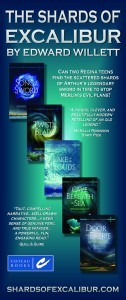 Mara isn’t the only 15-year-old fantasy heroine I’ve written about: there’s also Ariane Forsythe, heir to the power of the Lady of the Lake from King Arthur legend, who with her slightly younger friend Wally Knight, who has his own surprising heritage, must magically travel the world trying to recover the five shards of Arthur’s sword Excalibur before Merlin, in his modern-day guise as computer magnate Rex Major, can claim them first…because if he gets them, he’ll use the sword’s power to open the door into Faerie, where he originated; reclaim his full magical ability; and then seize control of our world to launch an invasion of his own.
Mara isn’t the only 15-year-old fantasy heroine I’ve written about: there’s also Ariane Forsythe, heir to the power of the Lady of the Lake from King Arthur legend, who with her slightly younger friend Wally Knight, who has his own surprising heritage, must magically travel the world trying to recover the five shards of Arthur’s sword Excalibur before Merlin, in his modern-day guise as computer magnate Rex Major, can claim them first…because if he gets them, he’ll use the sword’s power to open the door into Faerie, where he originated; reclaim his full magical ability; and then seize control of our world to launch an invasion of his own.
Ariane and Wally’s adventures are told in the Shards of Excalibur series from Coteau Books.
Doesn’t that sound like something you’d like to read?
Check out the series at its own website, or visit my Edward Willett website.
My other YA fantasy series wraps up: you’d probably like it
 Mara isn’t the only 15-year-old fantasy heroine I’ve been writing about: there’s also Ariane Forsythe, heir to the power of the Lady of the Lake from King Arthur legend, who with her slightly younger friend Wally Knight, who has his own surprising heritage, must magically travel the world trying to recover the five shards of Arthur’s sword Excalibur before Merlin, in his modern-day guise as computer magnate Rex Major, can claim them first…because if he gets them, he’ll use the sword’s power to open the door into Faerie, where he originated; reclaim his full magical ability; and then seize control of our world to launch an invasion of his own.
Mara isn’t the only 15-year-old fantasy heroine I’ve been writing about: there’s also Ariane Forsythe, heir to the power of the Lady of the Lake from King Arthur legend, who with her slightly younger friend Wally Knight, who has his own surprising heritage, must magically travel the world trying to recover the five shards of Arthur’s sword Excalibur before Merlin, in his modern-day guise as computer magnate Rex Major, can claim them first…because if he gets them, he’ll use the sword’s power to open the door into Faerie, where he originated; reclaim his full magical ability; and then seize control of our world to launch an invasion of his own.
Ariane and Wally’s adventures are told in the Shards of Excalibur series from Coteau Books, which just wrapped up with the release of the fifth and final book, Door into Faerie.
Doesn’t that sound like something you’d like to read?
Check out the series at its own website, or visit my Edward Willett website.

